Examining Charl Goussard’s #1307
Tom Spithaler
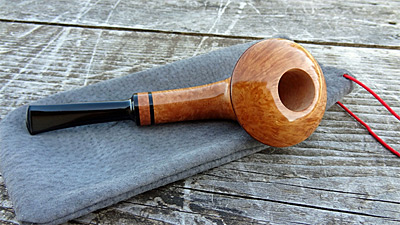
I grew up in the Pittsburgh, PA area playing the drums, and had some rather successful years in the music industry playing, writing and recording. Some of my work can be heard on records/CD’s to this day, but clearly not something that you would have remembered, or I would not be the struggling journalist I am today. As a drummer, I studied drummers and had the great pleasure of seeing some of my all-time heroes play live. Buddy Rich put on one heck of a show, and Ed Shaughnessy always gave him a run for his money. Steve Smith is best known for his years with the band Journey, but his best work by far is with his jazz band called Vital Information. I attended sessions with Kevin Valentine and Carmine Appice, and currently play a kit previously owned by the great Billy Cobham.
One drummer I studied, loved his style and never got to see play was Jeff Porcaro. A fantastic and innovative studio drummer who was a founding member of the band Toto, Jeff played with them from 1977 until his untimely death on my birthday in 1992. His rhythmic shuffle in the song Rosanna is immediately recognizable. Toto has recorded 17 albums sold over 35 million records, and is perhaps best known for its song Africa from the LP Toto IV released in 1982. Who can forget the clutching harmonies of, “God bless the rains down in Africa”? One man for whom the rains of Africa, South Africa in particular, are very important is, Charl Goussard. Charl is the artist behind this review.
When we consider the hot beds of pipe making, locales like Belgium, Denmark and Italy are perhaps the some of the first that come to mind. England and Ireland have quite a history to them with some major brand names who have stood the test of time as well. Of course we’d be reticent to not mention the thriving base of premium artisan pipe crafters in the United States earning a place on the international market as well. One place however, that you will probably not think of however is, South Africa. Hopefully, after seeing the work of Charl Goussard, he can help put South Africa on the map of quality pipemakers.
There’s no doubt that South Africa has had its share of problems. Since colonization by the Dutch in 1652, what is perhaps most remembered about South Africa are issues like the slave trade, the Zulu and Boer Wars, Apartheid, and now the plight of the AIDS epidemic. While South Africa may have had its share of struggles with sociopolitical issues (and really, what nation hasn’t), it just might lead the world in physical beauty, and terrestrial and oceanic biodiversity.
If anything stands out as a single illuminating factor for the South African people it may be this: an undeterred spirit that drives individuals to convictions beyond the norm, and in so doing developing a creative process that excels not only in patriotism, but in the under-appreciated fields of music, and the arts.
Charl Goussard is one of those people. The artisan skills of craftsmanship are naturally his. Married to his beautiful Lithuanian wife Ruta in 2001, Charl now has a 3 year old daughter that is his princess, “apple of his eye”, and sometimes referred to as the “briar fairy”! Carving since 2007, Charl confesses to have drawn his style from within while following the works of greats such as Nanna Ivarsson, Cornelius Maenz, and Poul Ilsted. He also gives great credit to his fellow craftsman and the camaraderie generated at the PipeMakers forum on-line.
A classically skilled pipecrafter, Charl sees things with the eyes of an expert engineer, and the heart of a man driven to excellence and diversity. Most pipecrafters recognize boundaries in certain areas of engineering and materials that while they have been held to standards for generations, are begging to be grasped, bent, and carved into submission – according to the progress of the artist’s spirit. Charl sees these boundaries not as limitations, but invitations to explore.

My first communication with Charl was over a brief profile I wrote on him and his work back in May of 2012. Since then we have exchanged emails and done our best to build our friendship. Charl, like so many other crafters in his field loves to share his experiences with pipe lovers all over the world. He has taken the time to author some very detailed blog posts that describe some of the more intricate work of carving pipes, including one that covers the complete installation of a bamboo shank. You’ll also find story lines that follow the making of commissioned pipes as well, keeping a running history of the progress being made. How wonderful this would be if you were the commission buyer! Based on this relationship, I invited Charl to participate in a pipe review and he agreed.
This was one of those pipes I knew was coming, but had no idea what I was getting. The anticipation mounted as time went by, and as one might expect, my mind was wondering over all sort of possibilities as to what it might be. It was not just ‘shape’ that I was wondering about, but material as well. Of course Charl excels with the use of spectacular choices in briar, a medium which is all he desires most to work with for stummels, but he has also produced some excellent works in olive wood, African Blackwood and more.
Charl’s stems are cut most often from ebonite, but do not be surprised to see Cumberland and the occasional acrylic. You’ll also find the liberal and tasteful use of shank extensions and accents made from olive wood. Charl also likes to use protea nitida (called waboom in native Afrikaans langauge), which a bush-become-tree that is found almost exclusively in South Africa, “which produces some very fine and interesting grain” Charl tells me. Few things impress, and at the same time intrigue me more than an international pipe crafter making good use of exotic materials that are indigenous to their environment.
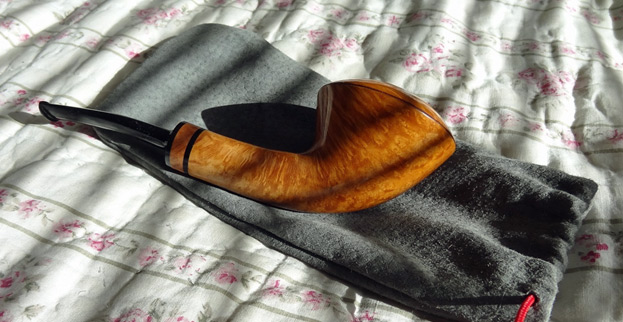
First Impressions:
The pipe arrived well protected in a heavily padded envelope posted from South Africa. The pipe inside the package was wrapped carefully in a tied gray leather sock. The sock is surprisingly strong for as thin as supple it is, and I inquired to find out it is made of native pig skin, and lovingly hand-sewn by Charl’s mother. Immediately one could tell that the finish was ‘deep’, and that the coloration/staining while natural, just popped. Two features that set it off were the rim-line blending the mushroomed perimeter of the pipe with the sire of the body of the bowl, and the ebonite accent ring at the end of the shank.
The pipe had some weight, but not what I would call ‘heft’, sat naturally in the hand despite the angled shape of the stummel and felt as smooth as glass.
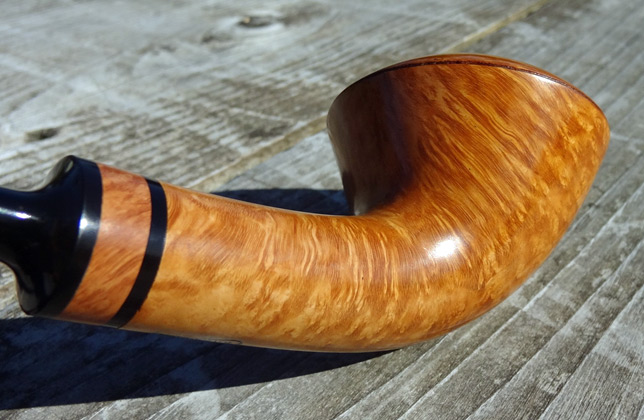
The Stummel:
This is an incredible piece of briar. In the profession of pipe carving, most who become successful have an intuitive eye for briar blocks, and take great pains to select the best blocks for each project. Charl is certainly no exception to this, which is evident by looking at any of the pipes you find in his on-line gallery.
This pipe, simply called “#1307” should be on display at an institute of higher learner so as to be able to reflect to the students so many of the aspects of briar’s grain. The shank and rear face of the bowl show straight grain blending to flame grain. The mushroom top and the ‘foot’ (if you can call such a rounded shape as having one) exhibit classic birds-eye so busy and plentiful, they seem like small hurricanes forming a foreboding weather pattern on the surface of a faraway apocalyptic planet.
This block was selected for this pipe and its preconceived shape. When I asked about how Charl decides how to make the shapes he does when it comes time to carve a new pipe, he replied:
“When I get a batch of new blocks, I normally go through them one by one, checking the grain, positioning, size etc. and then draw a rough idea of what I see should work. Sometimes the block totally dictates the shape, other times I adapt my idea for a certain shape to fit the block. So, in a way, the block determines what pipe it will become. In short, the fact that I had made a couple of similar looking shapes, might just have been the luck of the draw, so to speak!
I can’t actually see myself making the same type of pipe over and over. Except for being extremely boring, I like to push myself to do different shapes, try different applications, different materials. Without that, there will be no progress as an artisan.”
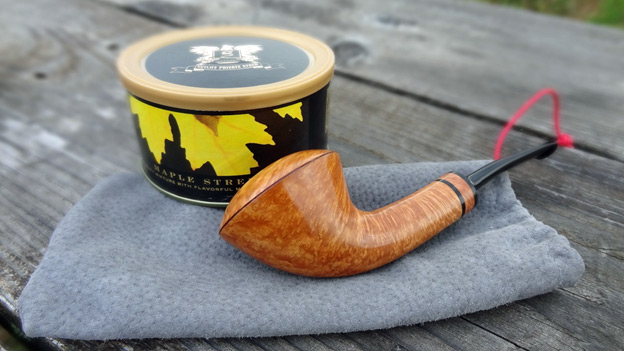
The depth of the grain is superb, and as it rolls in your hand seems to be communicating that no matter how you hold it, or the angle the pipe best suits your hand, or even which direction that the pipe points or from what angle the viewer might choose to take a closer look, that there is no such position that is not simply look stunning to behold.
The briar itself has tones that range from light tan to dark umber that are clearly the character of the wood, and not the product of the staining process. Part of the fun of #1307, is that it is a totally different pipe when viewed from the sides or the front. From the front, it’s all bird’s-eye that is seen, from the sides, the stunning straight and flame grains come to life. From the underside, the bird’s-eye is most prominent, but the fingers of the straight and flame grains are reaching from the sides of the shank and rear of the bowl as if they desire to pull the bird’s-eye in.
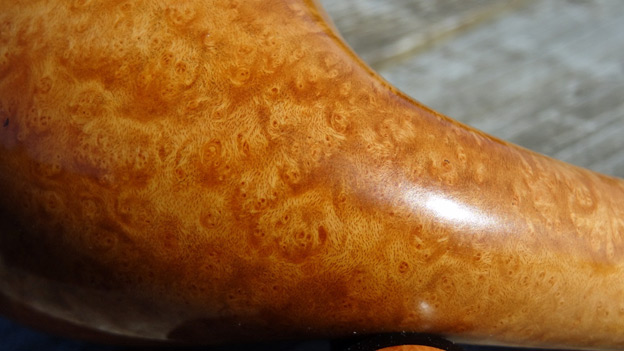
The size of this pipe is significant. I can see where it might be a limiting factor to the eye when being considered by a collector or smoker who enjoys lighter or more petite pipes. But I am constantly amazed at some briar and how light such a mass can be. The entire pipe weighs in at only 77 grams, but much like the heat in Arizona is so often called a “dry heat”, #1307 is a “light” 77 grams. Not the least bit distracting when carried in hand, its size draws attention and admiration from onlookers, but does pull on the mouth is left unsupported. Simple beauty exudes from #1307’s stature and would be at home by any night stand, easy chair or park bench.
What amazes me most about this pipe is that, even with this somewhat uncommon and certainly difficult shape to produce, it is completely unfaceted, and has smooth flowing lines front to back that cross over every angle. I know that portions of this pipe were produced on a lathe, turned to create the foundational sections of the bowl and shank. These areas are done with an artist’s hand and the pipe over-all shows brilliance in the aesthetics of the work. It is the fact that the rest of the lines blend so seamlessly to the balance of the pipe that show the skill Charl’s has at hand contouring and hand sanding, and it is just magic to the eye.
The Finish:
First of all Charl confesses, “smooth for me always wins over a blast…” and #1307 has what I’d call an elite finish. The surface is so smooth and the carnuba so exquisitely polished that it looks dipped in lacquer or poly. Having had the pipe for a couple of months now and smoking it regularly (ah yes, smoking it; but more on that later) I can attest to that fact that it is a wax polish as it will wear off and dull in time with handling, just like any other carnuba polish.
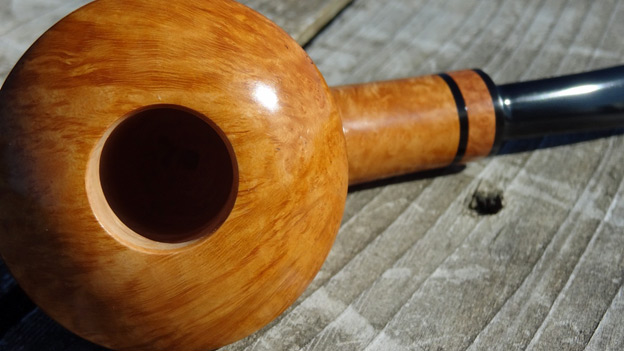
The finish is accomplished by Charl’s sanding and staining process that is the basis for the polish.
“After shaping on the disc and fine tuning with files, final sanding needs to take place. I start with 150, then 220, 320, 400 and 600 grit. Care must be taken to get all scratches out with each and every grit. It can be a real tedious job!
…my first stain is normally after 150 grit by hand. This is primarily to make sure all sanding marks and scratches are out and is basically all sanded away. It doesn’t really affect the final colour. Depending upon what I envision, (the) next staining normally occurs after 400 and maybe 600 grit. My pipes in general come out lighter than some other makers. I also have noticed a “tendency” to stain a pipe very light if the grain is really good and the stummel have little or no flaws.”
The Stem:
Made from imported ebonite (as Charl explains ALL things are imported to South Africa!), the stem is long and well accented. As an artist, here is where Charl really likes to explore. Getting away from using too many exotic materials for the stummels, using them as accents is in Charl’s wheelhouse.
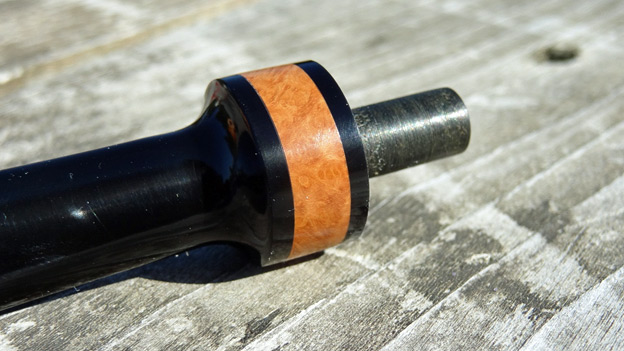
In this case, the accent is part of the stem and made from a companion piece of briar. The entire stem is nearly three inches long, blends marvelously from the thick curves at the shank end, tapering while it widens to a crisply cut bit providing an excellent purchase, all the while being gentle on the mouth. Polished to a bright glaring deep onyx finish it is crafted finely, and near as I can tell, engineered perfectly.
The fit of the tenon to the mortise is tight. Some might say too tight, but we’ll see how the pipe ages. I like a tight fit to begin with. Even if it stays tight it makes you, the consumer, pay that much more attention when removing the stem.
I simply enjoy just looking at this stem. It is a work of art unto itself. I love the gentle lines, the shallow curve, and the feel it has when I’m smoking #1307. Its size alone makes it a focal point of first impressions of the pipe, but at the same time, does not detract from the natural beauty of the briar. It is one of my favorite features and is very well done.
Engineering:
As mentioned earlier, Charl is not one to name his pipes, therefore you see the numbers. He is also not one to get caught up in making just one shape. When I asked Charl if he had a favorite he said he did not. So, I took the liberty to mention that the shape of #1307 seems to be one he liked, as I see the “theme” of this pipe repeated in his gallery. Inquisitively Charl responded:
“It’s quite interesting that you observed that I like this shape. At first I thought to myself: “Is that possible?” But after thinking back to the pipes I have made recently, you got me convinced! I do like that type of shape. Rhodesian-horn-dublin-esque, I suppose it could be called?! It is always very elegant, with flowing lines… Which I suppose is what I look for in a pipe.”
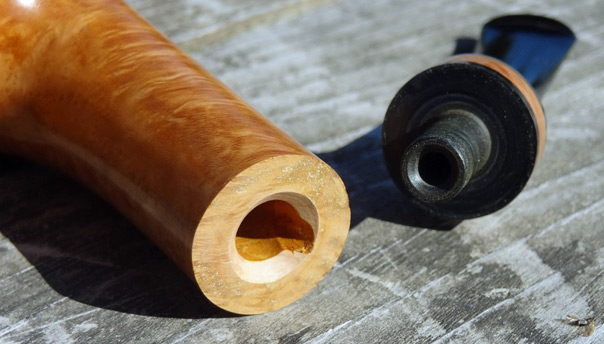
The engineering that goes into making such a flowing design on the exterior, means all the more important and difficult the work on the interior is going to be in order to make a great looking pipe, into a great smoking pipe! As an example, the bowl itself is slightly canted front to rear. Doing this allows for ample bowl thickness around the circumference of the pipe eliminating the risk of bowl-burn that scorches through the briar to the exterior. It also permits the vent to enter the base bowl perfectly at the bottom dead canter of the heel.
The bit, lip, bore, are all smooth and without blemish. The chamfering of both the shank bore and the tenon are consistent and produce unimpeded airflow.
Smoking:
I collect pipes with as much fervor as I do smoke them. If you are in any way like me you probably have one or two sitting on display somewhere that you just don’t want to smoke, you just want to look at them and admire them. Well, I had a hard time lighting up #1307, but in the name of journalism, I gave in – just for you all that is.
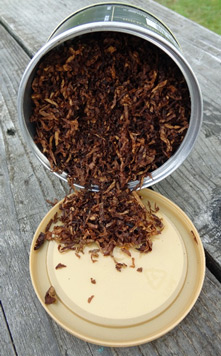 The bowl is more than ample – being just over ¾” wide at the top and 1.85″ deep, I filled the bowl about three-fourths of the way with a new tobacco I have to try. This is another example in the line of the Sutliff Private Stock Blends that I have been anxious to try. As you may know from a previous blog post, or two, I am a big fan of the Sutliff Private Stock of tobaccos. Having tried the CD and Molto Dolce blends, I opted for a new blend this time, Maple Street.
The bowl is more than ample – being just over ¾” wide at the top and 1.85″ deep, I filled the bowl about three-fourths of the way with a new tobacco I have to try. This is another example in the line of the Sutliff Private Stock Blends that I have been anxious to try. As you may know from a previous blog post, or two, I am a big fan of the Sutliff Private Stock of tobaccos. Having tried the CD and Molto Dolce blends, I opted for a new blend this time, Maple Street.
I filled, and packed the bowl with the Maple Street Blend, and the tin notes cannot be ignored. The aroma of a dark Caribbean rum was immediately present, while the maple took a back seat to the rum. When fired, that’s when the sweetness of the maple really came to life. Favoring aromatics, I have had many other maple cased blends, but this was different. The maple, while an ever present fixture of the blend, is not to me, overpowering. Made of ribbon cut Gold Virginia and White Burley with a touch of some dark leaf, the blend was not as wet as one might imagine for a flavored aromatic. It lit quickly, burned at an average pace, and smoked through #1307, it brought about a sublime experience.
Sitting outside at my picnic bench, looking out over the West Rocky Prairie Gamelands that border my new home, #1307 and the Sutliff Private Stock Maple Street seemed the perfect combination. Sipping a cup of herbal tea as a palate cleanser, drawing on Charl’s creation pulled a pleasant and cool smoke; enjoyable and relaxing as it should be. The balance of the pipe is of course forward in the hand, and the long stem really helps the smoker feel quite comfortable with a pipe the mass of #1307.
This pipe is big and elegant, and it smokes like a dream. The long draw adds to the pleasure and finishing a bowl of the Sutliff Maple Street passed my consumer test: it left me wanting more.
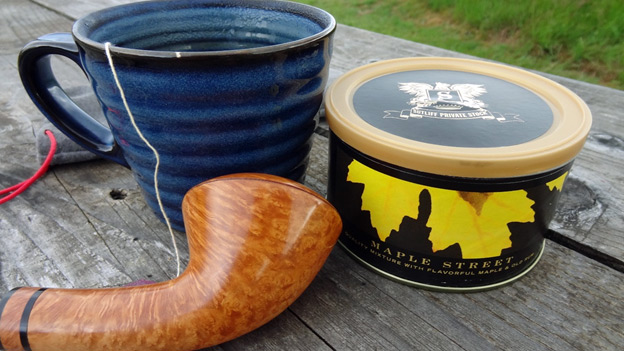
I’m not sure where this pipe will fit in my stable. While it hardly fits in a jacket or pant pocket comfortable to carry around the farm all day, I really want to! #1307 has eye appeal, grand elegance and smooth flowing lines, and carries with it an appeal towards sophistication, but its heftiness suggest strength, power, and a ruggedness that surpasses smoking parlor or meeting room only use. This is a pipe I can use anywhere, and I can see it being a partner of mine for a very long time.
I appreciate, and love to recognize those pipe carvers that give back to our community in ways other than just making their pipes available for sale. Through his web site and blogs, Charl is providing a static database of extremely useful tips in pipe crafting which go a long way toward furthering the hobby and nurturing young people as they seek to grow testing their own abilities in the hobby. To Charl, it’s not just about making an excellent pipe and bending tradition a bit to add his own styling; it’s not just about putting out pipes to satisfy distributor or reseller quantity goals. It’s not just about the money – it’s about using a talent he clearly has, to give back to a community that appreciates his work.
For most of my life, wise people have been telling that when it comes to most ventures in business or education or in a hobby that, “you only get out as much as you put in”. In this case Charl puts in a lot, more than most, and while I know he’s personally blessed for it, we, the hobbyists, consumers, collectors and up-and-coming carvers, are the ones that really get the most out of his efforts. Thanks Charl, for the opportunity to serve you back. #1307 has become a friend of mine, and your efforts have made that happen.

Specs:
Grade: Goussard
Stummel: Briar
Height of bowl: 55mm
Depth of tobacco chamber: 47mm
Bowlsize: 21mm conical
Length of pipe: 168mm
Stem material: Ebonite
Stem Insert: Briar
Weight: 77g
Bowlcoating: Naked
Price: $285
Resources:
http://www.goussardpipes.com/
http://goussardpipes.blogspot.com/
http://www.sturkstobacconists.co.za/index.html

Tom Spithaler is an Award Winning PSEA writer and member of the American Press Association who has cut his professional teeth in the outdoor and firearms media. Tom currently blogs at www.briarmeditations.blogspot.com, and operates Spithaler Media Services. A husband of 20 years and father of three, Tom currently resides in Tenino, WA. Contact: tom@bornagainbriar.com. |

















I really enjoyed the content, organization and development of this review. It very skillfully weaves the biographical and aesthetic elements that create the reader’s interest in a magnificent pipe. On syntax and grammar, ummm, not so much. When you have the time, go back and carefully re-read the piece.
.
As always, you have a knack for choosing fascinating pipes to review, and the wonderful photos that accompany the article generate a good deal of interest. I appreciate the work you put into each review, and I can hardly wait for the next installment.
I am the proud owner of three Goussard pipes. All of them are excellent smokers. Charl has a knack for creating very well made and balanced pipes. I chat with Charl on a couple of online pipe boards. He is a really generous fella and I’m proud to say he is a friend.
In regards to carvers from South Africa, you’d be surprised at the talent that comes from there. Charl Goussard & Jean du Toit (aka: Jan Pietenpauw & Son) are the top talent from RSA. This country is definitely worth a look for new carvers who turn out super high quality for decent price. It’s a shame that they don’t receive more notice from the pipe world at large. Maybe one day, they can be represented here at a major show, like Chicago, and really make their mark and put South Africa “on the map”!
Do you yourselves a favor and hit Charl up and have him make you, your very own masterpiece. You’ll thank me and Tom later.
Cheers,
Sean E. Noonan aka “DoverPipes”
This is a beautiful looking pipe. I love the simplicity and elegance of the shape, with its wonderful design. The broad head simply speaks volumes about craft and design. It looks fabulous. I will definitely look this up and also the maker and learn more. My thanks for bringing it to our attention. Your prose too is great, a real eye for detail and description. Thank you again.
Geo3rge